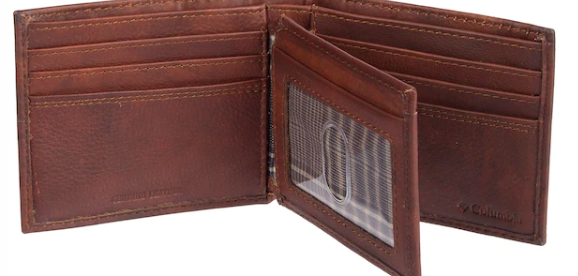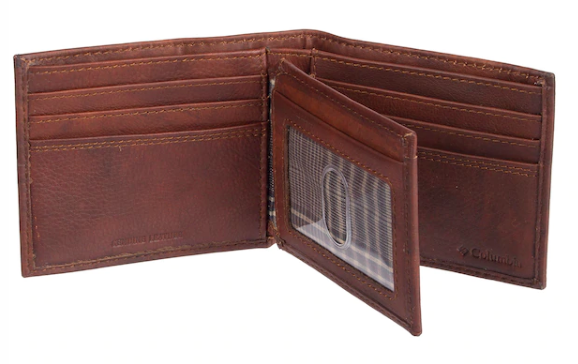It’s Genuine, but is it Genuinely Good?

Discount clothing stores — TJ Maxx, Kohl’s, Marshalls, and others if you’re in the United States — also tend to sell related items, such as wallets and belts. And if you’ve ever bought one of those and at any of those stores, you’re probably surprised to find apparently high-end wallets and the like for rather cheap. For example, pictured below is a “Men’s Columbia Genuine Leather Extra-Capacity Slimfold Wallet” for sale at Kohl’s for $32. That’s pretty good, right? It’s a name-brand product made with, as it says, “genuine leather” — the phrase is even stamped on the wallet itself. (If you can’t see it, here’s a larger picture.) And there are similar-looking wallets elsewhere that cost more than twice that.

The reason it’s so cheap? “Genuine leather” is a bit of a marketing trick.
As a general rule, if you’re looking to sell a product, you talk about its virtues and gloss over its deficiencies. If your product is high quality, durable, etc., you’re going to show that off. But it wouldn’t make sense to stamp your product with phrases like “not great, but it does the job” or “looks good for a while but will probably fall apart in a year or so.” So if you think “genuine leather” means that the wallet is going to be a great investment, it’s understandable.
It’s also wrong. Genuine leather is, at best, mediocre.
Leather usually comes in three different grades. Most leather experts consider the best to be “full-grain leather,” which, per the Associated Press, “is unaltered by sanding or buffing, so it retains the hide’s natural markings and is often thicker and more durable.” A full-grain leather item will last for many, many years, and its appearance will often improve over time, as it develops a patina with use.
One rung down on the grading scale is something called “top-grain leather.” When natural leather has markings that are too severe for consumers to tolerate, manufacturers will lightly sand or buff out the markings, per the AP. These products look a lot like full-grain leather products but aren’t likely to last quite as long.
Finally, there’s “bonded leather.” Again per the AP, bonded leather “has been reprocessed from many leather pieces, which typically have been ground up, reconstituted and glued together into a sheet.” It’s not really all that great, as you’d expect.
Genuine leather can be any of the above — all it guarantees is that the product is actually made of real leather. But it doesn’t make sense to label high- or mid-quality leather as “genuine,” as knowledgable consumers would hardly pay a premium for a product that may be made from bonded leather. As a result, as Business Insider notes, “goods marked as genuine leather will [typically] be several layers of low-quality leather bonded together with glue and then painted to look uniform. It’s made from what is left over when the other, higher grades are stripped away for pricier projects.”
All this shouldn’t be surprising — as the old axioms go, you get what you pay for, and if a deal is too good to be true, there’s probably something you’re missing.
Bonus fact: In the 1970s, Chrysler hired actor Ricardo Montalbán as its spokesperson. In advertisements for the cars, Montalbán, in his thick Spanish accent, would extol the virtues of the vehicles’ “Corinthian leather” interiors. It sounds special — but it’s probably not. In the 1980s, Montalbán was a guest on Late Night with David Letterman (watch the clip here), and the actor used the opportunity to tell the world the truth: “Corinthian leather” is just leather from New Jersey with a fun-sounding name.
From the Archives: Major League Baseball’s Dirty Little Secret: The balls are made with a leather exterior shell. But that’s not the dirty secret. (That, like Corinthian leather, comes from New Jersey.)
